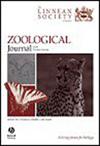Ontogenetic dietary partitioning in a Triassic sauropterygian: implications from a new juvenile specimen of Brevicaudosaurus jiyangshanensis (Reptilia: Diapsida)
IF 2.8
2区 生物学
Q1 ZOOLOGY
引用次数: 0
Abstract
During the first 10 million years of the Triassic, sauropterygians diversified rapidly into a variety of marine predatory niches. Adults of the late Middle Triassic eosauropterygian Brevicaudosaurus jiyangshanensis from southern China exhibit fang-shaped premaxillary teeth that resemble those of some nothosaurids and are adapted for feeding on large prey. Here, we report a juvenile example of the species, about one-third the length of the adult. The new juvenile shares apomorphies of the adult, like the posteriorly constricted parietal table, broadened humeral mid-diaphysis and short tail. However, its juvenile status is confirmed by unfused contralateral neural arch halves and developing epiphyses of the humerus. The small, smooth, conical premaxillary teeth of the juvenile differ from the ornamented fangs of the adult. The differences in the tooth morphology between the juvenile and adult suggest that this is an example of ontogenetic dietary niche partitioning, a common strategy for reducing intraspecific competition.三叠纪龙的个体发育饮食分配:来自一个新的幼年标本的启示(爬行纲:双翅目)
在三叠纪的前1000万年里,蜥脚类动物迅速分化成各种海洋掠食性生态位。来自中国南方的中三叠世晚期始翼龙济阳山短audosaurus jiyangshanensis的成虫显示出类似于某些颚龙的尖牙状前颌牙齿,适合捕食大型猎物。在这里,我们报告了该物种的一个少年例子,大约三分之一的成年长度。新幼鱼具有成鱼的形像,如后缩的顶骨表,加宽的肱骨中骨干和短尾。然而,其幼年状态被未融合的对侧半神经弓和正在发育的肱骨骨骺证实。幼龙的小的、光滑的、圆锥形的前颌牙齿不同于成年龙的有装饰的尖牙。幼鱼和成鱼牙齿形态的差异表明,这是个体发生饮食生态位分配的一个例子,这是一种减少种内竞争的常见策略。
本文章由计算机程序翻译,如有差异,请以英文原文为准。
求助全文
约1分钟内获得全文
求助全文
来源期刊
CiteScore
6.50
自引率
10.70%
发文量
116
审稿时长
6-12 weeks
期刊介绍:
The Zoological Journal of the Linnean Society publishes papers on systematic and evolutionary zoology and comparative, functional and other studies where relevant to these areas. Studies of extinct as well as living animals are included. Reviews are also published; these may be invited by the Editorial Board, but uninvited reviews may also be considered. The Zoological Journal also has a wide circulation amongst zoologists and although narrowly specialized papers are not excluded, potential authors should bear that readership in mind.

 求助内容:
求助内容: 应助结果提醒方式:
应助结果提醒方式:


